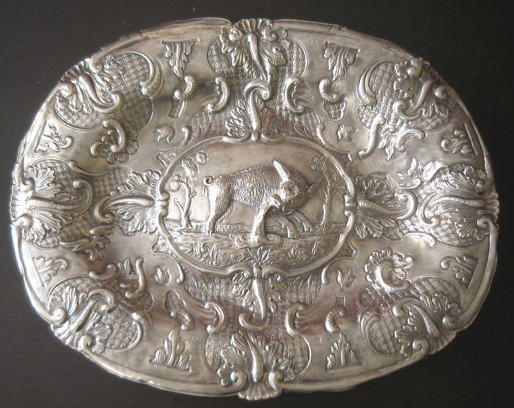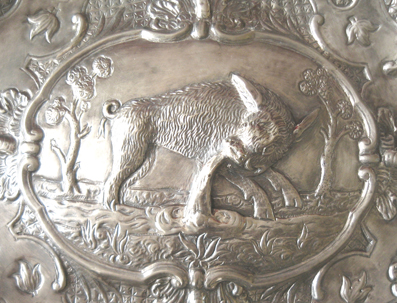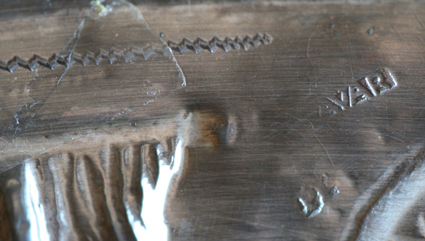The piece of the month of February 2008
JOSÉ DE YAVAR SILVERWARE
Ignacio Miguéliz Valcarlos
Chair of Navarrese Heritage and Art
The period of prosperity and enrichment that Pamplona experienced throughout the eighteenth century led to the development of the art of silverware, since the taste for luxury and the pomp of the Baroque meant that any work was likely to be made in silver. As a result, the patrician families of the city increased their silver jewelry not only with works for domestic use, but also with pieces of apparatus or representation, valued for their artistic beauty, with a sumptuary purpose, as is the case with the saucer in question, since the decorative richness of its carving, which does not offer a smooth surface, makes it unfeasible for the purpose for which its typology intended it, that of serving as a seat for another subject of objects or food in its presentation or service.

José de Yavar, "Azafate", ca. 1755.
In fact, this dish, which can be dated to around 1755, has a rich embossed decoration that completely covers its oval surface, formed by a straight edge with a molded mouth, a concave field and a convex and historiated emblem. The decoration is articulated by means of simple and fan-shaped "ces" and rocailles, which are symmetrically arranged in the axes and intermediate spaces, all arranged on a mesh of diamonds with dots in the corners, and alternating with thistle leaves, ces and floral elements, on a smooth surface, which surrounds all the decorative motifs. In the emblem, with a framework of caes, there is a wild boar immersed in a natural landscape, from which a stream of water flows from its mouth, in the manner of a source.

"Azafate". Historical emblem.
On the reverse are stamped the locality and maker's marks, as well as the engraving, as stipulated by the marking norms in Navarre, corresponding to Pamplona and José de Yavar. Although the Pamplona punch is largely frustrated, it can be identified with the second variant of the Pamplona mark used throughout the eighteenth century, a double P with a crown of three peaks and a curved lower edge, used between the decade of the 1920s and the decade of the 1960s, when it was replaced by a version very similar to this one, in which the spelling and size of it varied. While the author's mark, YAVAR, corresponds to one of the punches used by the Pamplona silversmith José de Yavar (1713-1777), son of the also master Hernando de Yavar (1671-1725), with whom he was first trained, going on later to finish his apprenticeship in the workshop of the Zaragozan silversmith José de Godoy, where he spent six years. This artist obtained the Degree of master silversmith in 1728, with the drawing of a holy water basin, of beautiful design, very correct in the stroke and profusely decorated with vegetal motifs. As we have already mentioned, he used two different types of marks staff, it seems that one replaced the other in time, on the one hand a head with helmet, and on the other his surname arranged in a single line and in capital letters, as it is stamped on the plate studied here. Numerous are the works of José de Yavar that have come down to our days, all of them religious pieces, except for the façade here presented, which is the only known civil works of this master, although we know that he received numerous commissions from private clients. Among his religious works we can mention the reliquary bust of the Magdalena of the Cathedral of Pamplona, the processional cross of Pitillas, the Echarri chrismieres, the monstrance of Azpilcueta, etc.

"Azafate". Marks: Yabar, Pamplona and burilada.
The type of saucer was very popular in the second third of the eighteenth century among the silversmiths of Pamplona, as evidenced by the fact that in the ordinances of the brotherhood of San Eloy of that city in 1743, in point 25, relating to the examination to obtain the Degree of master, included a list of twelve pieces of silver and nine of gold, among them a "prolonged tray carved in foliage and flowers, in the middle a History of half relief, weighing twenty-six ounces, a little more or less". Those aspiring to obtain the degree scroll of master silversmith were given a choice of three pieces among those included in the aforementioned list, and they had to first draw the design of the chosen piece to later carve it. The ordinances also demanded that the drawn tray had to have a half-relief story, logically located in the emblem, unlike what was done in other workshops, where the trays of this subject are mostly decorated with vegetal elements. Because of this, there are several examples of historiated coppersmith's work from the Pamplona workshop at this time, such as the one preserved in the church of Segura (Guipúzcoa), the work of the silversmith Lorenzo Laoz (†1795), which presents on the emblem a Putti mounted on a chariot pulled by a goat. Likewise, and in spite of the fact that in the aforementioned ordinances it was specified that the saucer should be "carved with foliage and flowers", the change and evolution in taste, after the Baroque plenary session of the Executive Council , meant that these elements were substituted by simple and fan-shaped "caes" and rocailles, more in keeping with the taste of the time, As we can see in the Examination Book of the Pamplona silversmiths, where thanks to the choice by several masters of the azafate as an examination piece, we can appreciate the evolution that this typology underwent throughout the seventeenth century, adjusting its decorative motifs to the new tastes and styles, from Baroque to Classicism.
bibliography
GARCÍA GAINZA, Mª.C., Ancient drawings by the silversmiths of Pamplona, Pamplona, EUNSA, 1991.
MIGUÉLIZ VALCARLOS, I., "Baroque silverware from the Pamplona workshop in Guipúzcoa", in Príncipe de Viana, nº 237, 2006.
ORBE SIVATTE, M., Platería en el centro de Pamplona en los siglos del barroco, thesis doctoral sustained at the University of Navarra, 1999, (unpublished).
